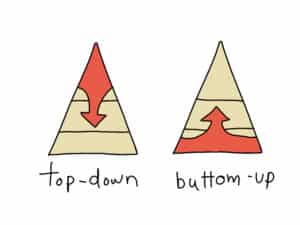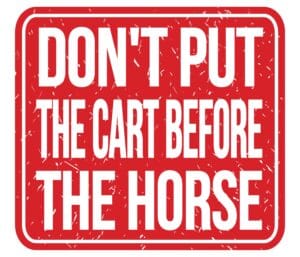
– To listen as a podcast
– To watch it as a video
– To stay in the loop, subscribe to our Newsletter
In 2022, Meta’s stock has lost about more than half a trillion dollars in value, while Apple’s revenue is expected to increase at around 6%, to be around $88+ billions.
Business Strategy is related to business models, visions, planning, financial operations, product development, market shares, sales, profits… Business strategies are general and comprehensive guiding strategies for a company’s leaders to reach revenue targets, goals and growth.
Brand strategy is about cultivating long term brand loyalty based on values, emotional affinity, social connection, as well as shared philosophies and beliefs. Brand strategies are more than selling products and services, but creating a community of followers by applying a brand’s solutions to their pain points and satisfying their desires. Brand strategies lead to improvement of functionality and differentiation from similar products and services.
Marketing strategy is related to sales and marketing performance for achieving specific results, and “about the here and now, specific numbers and measurable results. It focuses on increasing the brand profit over a certain time and deals with specific tasks: attracting or retaining a quality target audience and ensuring ad campaign profitability.” Marketing strategies are formulated and tweaked based on data and touch points constantly “live streamed” from the frontlines of marketing and sales.
Now the question is: Which comes first – business strategies before brand strategies and marketing strategies? Or vice versa?
Meta recently reported significant losses in revenue after it rebranded itself from Facebook to Meta and invested tons of money and resources in metaverse, AR and VR.
Meta was way over its skis. Lured by what it THINKS is the cutting edge next gen technology, it was trying to drive or even beat the market, instead of being market-driven to serve the market.
This article is not intended to explore the future for Metaverse, Web3, AR and VR. My question for Zuckerberg is: What were the specific and immediate pain points Meta was trying to solve for a large quantity of consumers with Metaverse, Web3, AR and VR? Is there a widespread consumer demand?
After billions of dollars went nowhere, 11 thousand employees were laid off as scapegoats for Meta’s directional mistake, I am hoping Mark Zuckerberg will at last learn this painful lesson: had he first verified in advance exactly what practical and immediate paint points Meta was going to solve for consumers, on a large scale, he could have totally avoided losing billions of dollars, 11 thousands employees, and rebranding Facebook into Meta all for nothing.

Such a fundamental pivot from Facebook to Meta, in both substance and in name, was not based on thorough and accurate market research of what consumers truly need, and sound marketing strategies to serve their need, but rather, in a top down fashion, driven by what Mark Zuckerberg was thinking in his own head. Their business strategies led brand strategies, resulting in the change of Facebook’s identity to Meta, and later led their marketing strategies to implement both the new brand and business strategies.
As long as Meta views its users as a mass to be manipulated for its own revenue gains, and fails to meet users’ desires and needs for personal data privacy and autonomy, Meta will never be able to feel the pulse of the market, alleviate consumers’ pain points, and remain profitable by offering services thereof.

I regard this simple truth to be almost self-evident: consumers care about how their own personal data is used and user experience far more than AR, VR, metaverse, Web3. Why was it so hard for Mark Zuckerberg to get this?
Mark Zuckerberg said this on Nov. 9, 2022: “the macroeconomic downturn, increased competition, and ads signal loss have caused our revenue to be much lower than I’d expected. I got this wrong, and I take responsibility for that.“
In the good old days of Facebook’s birth almost three decades ago, weighing both the good and the bad, the good part that drove Facebook into existence was to solve people’s desire for connecting online, which was outweighed by the bad part of Facebook using consumers’ private information for targeted advertising revenues.
Over the years, nothing has been done about the bad part. Mark Zuckerberg failed again and again to truly learn from his mistakes to change his business model. They just let this cancer grow.
Even though Apple’s new iPhone 14 is not selling like hot cakes due to supply chain delays, inflation, low demand, and other factors, Apple has also been innovating with new products and services such as subscriptions to AppleTV+ and Apple Music, where it offers advertising-free live streaming.
By prioritizing user experience to serve users’ desires for privacy and autonomy, Apple adheres to its brand DNA.
Autonomy – even though a tiny measure, Apple gives consumers a choice with their subscription payment to pay for live streaming without annoying ads.
Privacy, or in the name thereof, “Apple’s push to deliver better consumer privacy has upended Facebook’s ads game of targeting hyper-specific audiences.”
Instead of “selling out” users’ personal data for targeted advertising by Meta, Apple offered ads on the App Store. To meet users’ yearning for privacy, Apple came up with the ”App Tracking Transparency Privacy Policy” that requires apps to ask for permissions before tracking users’ activities.

At the beginning of 2022, “Apple search ads skyrocketed from driving 17% of all iPhone app downloads attributed to advertising to 58% in just one year, according to mobile analytics firm Branch.”
Towards the end of 2022, while both Meta and Google have experienced big losses from their shrunken advertising revenues, Apple has scored a substantial increase in profits from subscriptions to AppleTV+ and Apple Music, directly benefiting from its App Tracking Transparency privacy changes.
Apple thus has de-positioned the competition with Meta and Google by branding itself as the “guardian of privacy.”
Apple did it right (for now), by prioritizing user experience and consumers’ need for privacy, autonomy, and personalized functionality, it has put the “horse” – consumers’ pain points, needs, desires – in front of the “cart” – technological innovation.
Meta has put the cart before the horse: instead of being guided by CONSUMERS’s needs and wants in formulating Meta’s business, brand, and marketing strategies, Mark Zuckerberg was carried away with a fantasy and lost touch with reality.

Meta is not alone in putting the cart before the horse. Many entrepreneurs and business leaders make the same mistake. I see, almost daily, from my own coaching and consulting, how some very talented and highly educated business leaders also have difficulty in focusing on the right things.
The vulnerability for decision making is in the traditional business management model of “command and control”, where key decisions “trickle down” from top of the hierarchy.
The C-suite must always stay in touch with the “pulse” of the market. The market is the horse that pulls the cart.
How to do that? How to see one’s own blind spot?
How can CEOs, entrepreneurs, and leaders avoid putting cart before the horse?
To avoid Meta’s mistake, it is high time to transform a top-down decision making hierarchy into a decentralized decision making “feedback loop”, where first hand information, data, insights about user experience from the market, collected constantly from sales, marketing, brand management, are fed into a self-looping channel for all departments and among all decision makers – product development, corporate policies for long and short term growth, customer relations, brand management, marketing and sales, and the C-suite -, so that decision making, be it for the directional business strategies, brand strategies, or marketing strategies, is based on market changes and pulses, and decision making is a more integrated, collaborative, and more fluid process.
A proactive C-suite needs to closely follow and improve brand strategies based on marketing strategies, by first identifying customers’ needs in the marketplace, then tweaking business strategies for adjusting products and services, in order to satisfy customers’ exact needs.
To offer the right solutions for your clients’ pain points, the information, data, and insight come primarily from the marketing and sales frontline, which is a conduit of data and facts collected from the marketplace. This first hand real time information bridges the reality gap between what the market truly wants and what a CEO believes to be the reality (that may be distorted).
To help C-suite get out of their own heads, to see their blind spot, with an outside- their-own-forest perspective, hiring an experienced brand consultant, marketing analyst, and brand strategist (from 10PlusBrand.com) can add great value.
Among marketing strategies, brand strategies, and business strategies, there is no leader or follower, they mutually feed off each other, like yin and yang, constantly in motion and in sync. Brand strategies and marketing strategies are an integral part of business strategies.
Both short term cash flow and long term growth demand business strategies to be based on sound brand strategies that guide marketing strategies, for both B2C and B2B companies.
Short term profit goals must be the result of persistent and unfailing mid to long term strategies and implementations thereof. An ideal situation is to have a loop of data and information collected from the “frontline” of marketing. The data constantly feeds, informs, and refines brand strategies, which are all part of business strategies, rather than relying on what the leadership thinks what the market wants.
Product development, marketing, sales, customer success and customer service must closely collaborate to make customer experience the #1 priority, in order to sustain growth of a business entity.
=========================================
Joanne Z. Tan is the founder, CEO, Brand Strategist of 10 Plus Brand, Inc., an award-winning, full service, multi media branding, branding building, and digital marketing agency. Located in the San Francisco Bay Area, 10 Plus Brand serves businesses and leaders nationally in all 50 states in the US, and globally in three continents. 10 Plus Brand focuses on B2B branding and brand marketing for service providers such as consulting agencies, law firms, accounting firms, independent insurance agencies, engineering, high tech, SaaS, manufacturers.
Please visit our website where you can send us a message in “Contact Us“, or call: 888-288-4533.
Nov. 27, 2022
© Joanne Z. Tan, all rights reserved.
Please don’t forget to like it, comment, or better, SHARE IT WITH OTHERS, – they will be grateful!
– To stay in the loop, subscribe to our Newsletter
(About 10 Plus Brand: the “whole 9 yards” is not enough, we go 10+ to exceed your expectations in brand building, digital marketing, and content creation for both business and personal brands.)
– Visit our Websites:
– Find us online by clicking or follow these hashtags:
#InterviewsofNotablesandInfluencers
